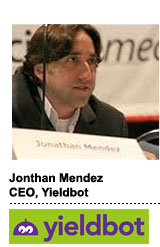 For the past couple of years, Jonathan Mendez, founder and CEO of Yieldbot, has been focusing his company’s efforts on unlocking the value in publisher data – specifically “intent.”
For the past couple of years, Jonathan Mendez, founder and CEO of Yieldbot, has been focusing his company’s efforts on unlocking the value in publisher data – specifically “intent.”
Last week, Mendez discussed with AdExchanger the evolution of his company’s analytics product and its move towards media.
AdExchanger: Since I last spoke with you on AdExchanger in January 2011, what’s changed for the digital publisher?
JONATHAN MENDEZ: I’m not sure anything has changed. Their CPMs are continuing to fall driven by audience buying and exchange-based inventory, which continues to scale. There continues to be more data coming to market, too. And now Facebook Exchange has doubled the global amount of RTB inventory at 1/5 of the price. There are huge price pressures.
In fact the only change for publishers is that pricing pressure has accelerated. There are still no answers for publishers on how to counteract in and how to play in the world. First, we had the idea of private exchanges, but now two years later, clearly that is not working.
Why do you think private exchanges are not working?
Publishers I have spoken to say there is no demand on the buy side. The advertisers have no reason to buy in a private exchange when using their audience data and going elsewhere is cheaper.
From the publisher’s perspective, it sounded like a great idea initially, but once the integrations were done there just were not the dollars flowing through.
So does guaranteed media end up getting commoditized from here?
Yes. I think guaranteed media is on the way out. The trend is clear. And, buying impressions is dying, too. People buy based on data points and most data points are keywords because ultimately that is what is driving performance for the advertisers. It’s measurable and can be optimized against.
So how does Yieldbot’s business fit in here? It sounds like a pretty bleak picture for publishers.
What we do is extract the most valuable data for advertisers – that is first party-publisher-data. There really haven’t been any technologies that have been built to capture, organize, and activate that data.
We have spent 2 1/2 years building the technology. Publishers have been sitting on gold all this time, but they have not been able to mine it. Where we fit in is we not only do we do the mining, but we turn it into the most valuable currency of the web – intent – and we bring a new buying audience to bear against that intent: keyword buyers.
Up until now, premium publishers have not been able to connect to search engine marketers and other performance-based advertisers and their budgets. This is exciting for publishers because that marketplace is twice the size of the web banner marketplace. In terms of the ability for them to get new sources of revenue and to play the performance advertising economy which is the one that is growing, not the impression-based-buying economy. For publishers to play in it and to realize the value of it, that is where we fit in.
How have you adjusted your business in the past year and a half? Any learnings?
I think we knew going in, we were bringing something new to market, and that it would require a lot of evangelism and education. We have done all of those things.
Publishers are very cautious. They are still afraid to move away from these business models that are clearly failing, especially, around impression-based buying and selling. Old models die hard. That is the learning.
What is a typical use case for Yieldbot products today?
Publishers’ business is based on traffic, page views. However, they have never had a monetization system that intelligently understands what attracted the intentions of that traffic on every single page view of that site.
We allow publishers to see their site through the lens of intent by resolving every page view to multiple keyword values. They are ranked similar to “quality score” in search. We bring that all together into our analytics package where publishers are able to see through the words and the intentions of their visitors what’s working and what’s not working.
We are able to understand at the URL level – the URL of the page is our atomic unit of data collection. We are looking every single referrer and every single visitor that comes to those pages serializing the data from their clickstreams and how they got there. Then seeing what happens when they leave. Resolving all that to keyword values.
How important is context to the analytics that you provide?
We don’t take any page level attributes. We are concerned with the referred data and serialization of the clickstream from each referred step that got that person to that page – steps which we can discern. If it is four clicks into the session, we understand all four pages that drove the person there. We are built on understanding why someone is coming to the page based on referrer data, not what the page is about based on page-level data.
That is the fundamental difference of our technology. It goes back to my experience at Offermatica (now part of Adobe) where the landing page optimization technology is completely based on referred data. But the most valuable referred data of all to publishers is very internal session data. The referred data from Google only makes up a very small percentage of page views overall. The sessions can extend on average 6 1/2, seven pages per session.
That click stream, that referred data is where the most valuable data is extracted and where the most value is provided both to the publisher and to the advertisers. Our clickthrough rates in-session are double our clickthrough rates on landing pages. That was one of the most counterintuitive things for us. Typically, people think first page views are one of the best page views the server has.
But what we have found is very different. We are getting smarter with the click streams.
How does pricing work with YieldBot?
We sell everything on a CPC, cost per click. Advertisers come to us and buy keywords just as they would in search. We are happy to work with publishers either as a buyer or seller – and that is very unique. If a publisher would like, we will buy their media from them. We prefer to work in a partnership in a revenue share arrangement, but not every publisher wants to work that way which is fine, so we will work either way that they want.
How long does an integration take with publishers?
We have our intent tag, which is the core tag of YieldBot, and it can be implemented in a minute. It’s very similar to a Chartbeat or Google Analytics tag. It goes on one time and does all the data collection. It also serves as our real-time decision engine.
The ad integration can take a few days with a publisher generally. We are integrated with the publisher’s ad server, but unless we have a match, a real-time match we sit there “silent.” When we have a real-time match, we send a request to the publisher’s ad server. They serve the match, they allow us to serve based on their rules. The publisher always has 100% control of when we serve. It’s a very clean and healthy integration.
What does Yieldbot look like today in terms of headcount and where you think you might be going with that? Are you just based here in New York?
We are co-located. Our engineering team is in Maynard, Massachusetts. Our sales and business team is located in New York. We have grown that way from the beginning. We are now up to 16 people. We started our monetization for publishers in May. It has been going really well.
We’ve been doubling our revenues every month and hope to continue that pace for the near future. We just hired some more salespeople on the ad sales side. And on the publisher side, we are fast becoming one of the leading sources of revenue for our publishing partners. It’s getting into the mid-five figures a month for our largest publishing partners right now.
In order to accelerate our growth, our next [funding] round is about to start and I would expect it to close in Q1 of next year.
12 to 18 months from now, what are a couple of milestones you would like to accomplish?
A couple of milestones? I don’t ever look at more than a month or quarter ahead… But, looking that far off, we are starting to think about mobile. That is an exciting area for us within the next 12 to 18 months. Publishers have not done anything in mobile. All the publishers we have now, anywhere from 10 to 30% of their page views are mobile and growing.
Also, we will continue building out our vertical approach. Our biggest verticals now are around women’s health, fitness and beauty. Then there is home, home improvement and finance. Those are the verticals that we have been focused on this year. In the next 12 to 18 months as well, we think there are some interesting verticals that we can start to move into.
Follow Jonathan Mendez (@jonathanmendez), Yieldbot (@yieldbot) and AdExchanger.com (@adexchanger) on Twitter.













